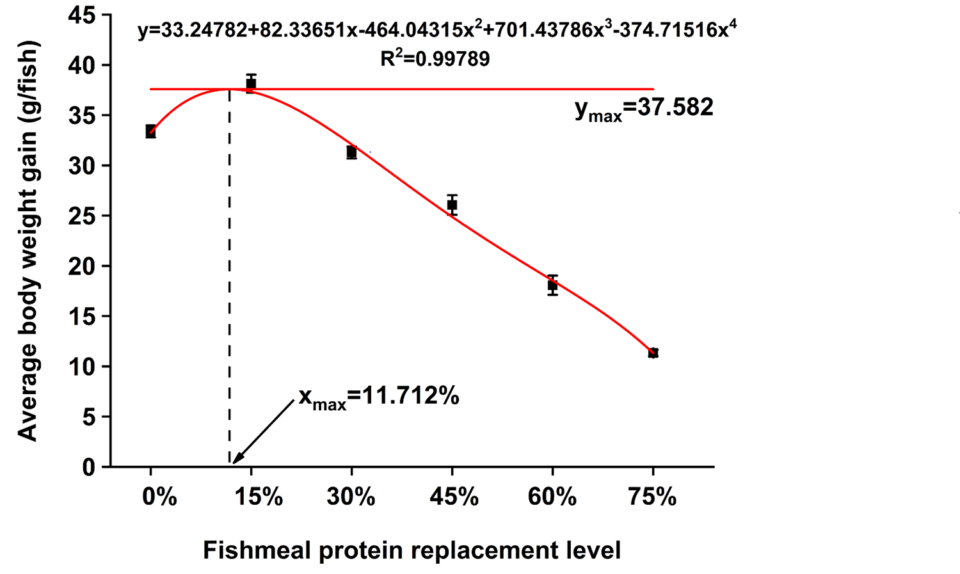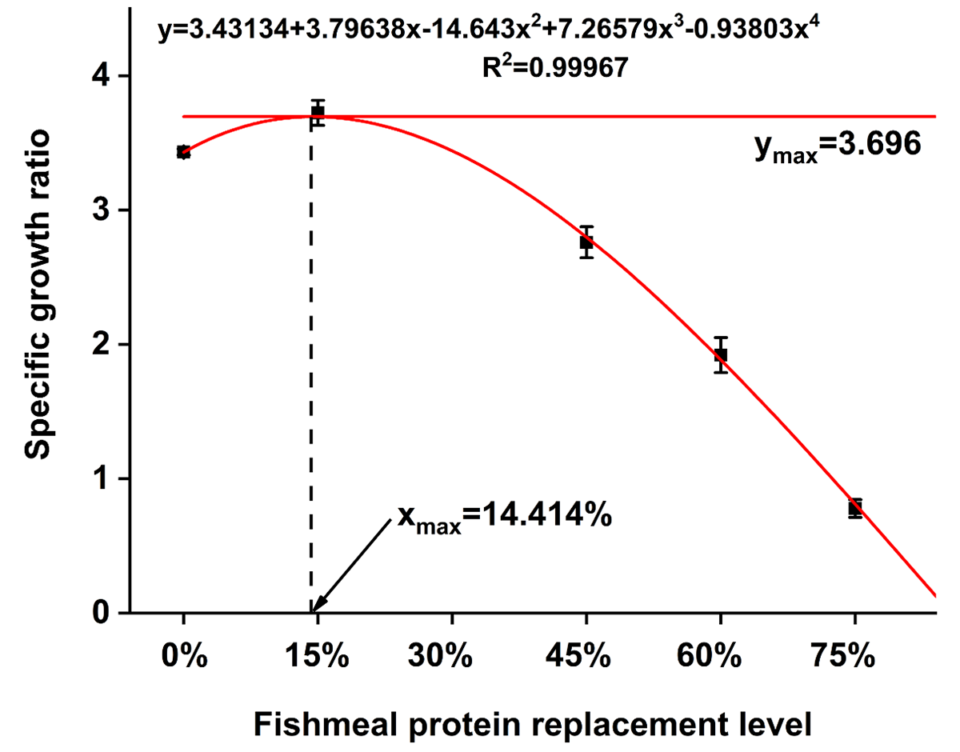Results show inclusion levels should be kept below 30 percent

Several studies have assessed the influence of SPC on fish during the past 20 years, and results showed that different species have unequal levels of tolerance for SPC. Research has shown that SPC can effectively replace fishmeal as a protein source in the diet of some commercially important fishes like Atlantic salmon, rainbow trout and pompano, while other species only tolerate some levels of SPC.
The pearl gentian grouper – a hybrid species (Epinephelus lanceolatus ♂ × E. fuscoguttatus ♀) – is an important commercial fish that grows rapidly, has strong disease resistance and is highly nutritious. It is widely cultured in China using land-based and sea-cage techniques and is mainly fed with formulated pellet diets. As a typical carnivorous species, pearl gentian grouper requires high protein and is heavily dependent on high levels of fishmeal in its diet to meet its protein requirement, resulting in higher production costs. It is still unknown whether it is possible to replace fishmeal with SPC for pearl gentian grouper.
This article – adapted and summarized from the original publication – reports on a study of the effects of fishmeal replacement by soy protein concentrate on the growth performance, apparent digestibility and retention of protein and amino acid in juvenile pearl gentian groupers.
This work was supported by the Natural Science Foundation of Hainan province (No. 20163074 and No. 20163071), Major Science and Technology Projects in Hainan Province from Science and Technology Department of Hainan Province government, China (No. ZDKJ2016009), Hainan Key Laboratory for Conservation and Utilization of Tropical Marine Fishery Resources and Sanya Key laboratory of seawater aquaculture research (No. L1507). Thanks to National Feed Engineering Technology Research Center (Beijing, China) and Beijing Longkefangzhou Bio-Engineering Technology Co., Ltd. (Beijing, China) for their help to detect the anti-nutrition factors in SPC and experimental diets.
Study setup
Pearl gentian grouper were purchased from a commercial hatchery (Hainan, China). Before the trial, fish were stocked in an indoor recirculating aquaculture system at the Hainan Key Laboratory for Conservation and Utilization of Tropical Marine Fishery Resources (Hainan Tropical Ocean University, Sanya, China) for two weeks, and fed a commercial diet (Nisshin Flour Milling Co., Ltd., Japan) twice daily to satiation.
The fish (8.00 grams ± 0.10) were randomly distributed in 18 tanks – 500 liters each tank, 50 fish per tank – in an indoor seawater recirculating system and each diet assigned tanks in triplicate. The fish were fed twice a day, and feed intake of each diet and mortality of the fish were recorded in each tank. Six isonitrogenous and isocaloric diets (46 percent crude protein, 18 MJ/kg gross energy) were formulated and used in the study. In these diets, SPC replaced 0 to 75 percent of fishmeal protein (SPC0, SPC15, SPC30, SPC45, SPC60, and SPC75).
After feeding the fish with diet in each tank for 30 minutes, the uneaten diet was siphoned out and dried overnight at 50 degrees-C before being weighed to avoid any contamination with feces. And the weight of the uneaten diet was subtracted to calculate the daily feed intake in each tank. Feces were also collected from each tank daily for 30 days (from day 12 to day 42 of the feeding trial), for lab analyses.
Water quality in the tanks was monitored daily and maintained at a temperature of 29.2 ± 0.4 degrees-C; dissolved oxygen at 7.10 ± 0.2 mg/L; salinity at 25.8 ± 0.5‰; pH at 7.2 ± 0.2; and total ammonia nitrogen at 0.3 ± 0.2 mg/L.
For detailed information on the experimental design and diet formulations; feeding trial; sample collection and calculation formula for growth performance; and biochemical and statistical analyses, refer to the original publication.
Results and discussion
Final survival of juvenile pearl gentian grouper was significantly affected based on the concentration of dietary SPC. Fish survival was higher in groups SPC15, SPC30 and SPC45 (from 94 to 96 percent), compared to SPC60 and SPC75. The body weight gain (BWG), weight gain rate (WGR), specific growth rate (SGR) and protein efficiency ratio (PER) increased in fish fed with diet SPC15, but gradually decreased with further increase of SPC concentrations. Conversely, the feed conversion ratio (FCR) values significantly decreased in groups SPC15, SPC30 and SPC45, but increased in the SPC75 group, suggesting that SPC15, SPC30 and SPC45 had a significantly higher FCR.
The daily feed intake (DFI) was significantly higher in SPC0 compared to the groups treated with SPC, suggesting there was a significant effect of dietary SPC on fish DFI. The hepatosomatic index (HSI; ratio of liver weight to total body weight – a measure of the energy reserves of an animal, especially in fish) of fish was significantly higher in group SPC0 compared to SPC30 and SPC75, but had no significant differences with SPC15, SPC45 and SPC60. Based on regression models of BWG corresponding to SPC replacement levels (Fig. 1), the optimal SPC replacement level was 11.71 percent. However, based on SGR and dietary SPC replacement levels, the optimal level was 14.41 percent (Fig. 2).


Regarding the approximate composition of the whole body and muscle of the groupers, in the dorsal muscle the moisture and protein content were affected based on the concentration of dietary SPC, while other compositions were not influenced. There was no significant difference in the crude protein of the dorsal muscle in fish fed with SPC0, SPC15 and SPC30 diet. However, those values were significantly higher compared to fish fed with SPC45, SPC60 and SPC75, with the increasing dietary SPC concentration. The moisture of the dorsal muscle showed an opposite trend.
For whole body, the approximate components showed significant differences. The moisture content gradually increased with increasing SPC concentration and reached its maximum value in fish fed with the SPC75 diet. The fish fed with diets from SPC30 to SPC75 had significantly higher whole-body moisture than for groups SPC0 and SPC15. The crude ash showed the opposite result. Crude protein content of the whole body in groups SPC30 and SPC45 was significantly higher among all the SPC treatments and decreased in groups SPC60 and SPC75.
In our study, fish fed the SPC15 inclusion diet had a relatively better growth performance, and other treatments showed a gradual decrease with increasing SPC concentration. Plant proteins can be used in many fish diets for the partial or total replacement of fishmeal, as an option to reduce production cost. Among the plant proteins, soy products are nutritionally superior ingredients of feeds for aquatic animals. Several studies have reported that when dietary SPC inclusion was below 60 percent, a satisfactory growth and feed utilization was obtained for a number of species. Further increases of SPC inclusion in the diet led to lower diet utilization and higher mortality.
Some reports argued that lower growth performance may be related to a decrease in feed intake rather than nutritional imbalance or deficiency. This was suggested because plant proteins are usually less palatable to fish than fishery ingredients. In our study, when fish were fed diets with high levels of replacement of fishmeal with SPC, a reduction in DFI was observed, which could cause reduced growth. We noticed that high SPC inclusion (above 60 percent) caused reduction in diet utilization, as reflected by an increase in FCR in our work. similar results have been reported for other fish species.
In our study, along with the growth performance of fish, the crude protein levels in muscle of fish fed a diet with 45 to 75 percent SPC replacement were also significantly decreased. And the whole-body protein of fish fed with a diet with 60 to 75 percent SPC replacement had significantly lower values. This could have been caused by possibly deficient levels of the amino acids methionine and lysine in the SPC-based diet and an imbalance of essential amino acids. The addition of feed attractants and amino acid supplementation are suggested strategies for further research.
Perspectives
Our results demonstrated that juvenile pearl gentian grouper have limited tolerance for SPC. The maximum level of SPC substitution for fishmeal in the fish diet, according to weight gain and specific growth rate, was estimated to be 11 to 14 percent. However, the 30 percent SPC replacement did show a positive influence on protein and amino acid retention. Therefore, we suggest that SPC replacement of fishmeal for juvenile pearl gentian grouper should not be more than 30 percent.
Now that you've finished reading the article ...
… we hope you’ll consider supporting our mission to document the evolution of the global aquaculture industry and share our vast network of contributors’ expansive knowledge every week.
By becoming a Global Seafood Alliance member, you’re ensuring that all of the pre-competitive work we do through member benefits, resources and events can continue. Individual membership costs just $50 a year. GSA individual and corporate members receive complimentary access to a series of GOAL virtual events beginning in April. Join now.
Not a GSA member? Join us.
Authors
-
Dr. Yan Chen
Hainan Key Laboratory for Conservation and Utilization of Tropical Marine Fishery Resources
Hainan, PR China
College of Life Science and Ecology
Hainan Tropical Ocean University
Sanya, PR China -
Dr. Jun Ma
Hainan Key Laboratory for Conservation and Utilization of Tropical Marine Fishery Resources
Hainan, PR China
College of Life Science and Ecology
Hainan Tropical Ocean University
Sanya, PR China -
Dr. Hai Huang
Corresponding author
Hainan Key Laboratory for Conservation and Utilization of Tropical Marine Fishery Resources
Hainan, PR China
College of Life Science and Ecology
Hainan Tropical Ocean University
Sanya, PR China -
Dr. Honggan Zhong
Sanya Municipal Bureau of Ocean and Fishery
Hainan, PR China
Tagged With
Related Posts

Aquafeeds
Increased density improves grouper feeding response, growth
A growth trial using hatchery-reared grouper was carried out to study the effects of stocking density on feed intake and subsequent growth. Contrary to common perceptions, fish stocked at the highest density had higher feed intake and body weights.

Health & Welfare
Soy products replace fishmeal in offshore cobia feed study
A project of the Soy-in-Aquaculture program evaluated the feasibility of using soy protein concentrate and soybean meal to replace fishmeal in cobia diets.

Health & Welfare
Soy-based diets support white shrimp performance
A study evaluated Pacific white shrimp given plant protein-based diets with varied lipid content and soybean meal:soy protein concentrate ratios.

Aquafeeds
Soy trials replace fishmeal in grouper feeds
Although groupers present desirable traits as an aquaculture species, the high cost of feed for the carnivorous fish limits expansion of grouper culture. The author performed two trials to evaluate the performance of tiger grouper juveniles fed soybean meal-based feeds.


